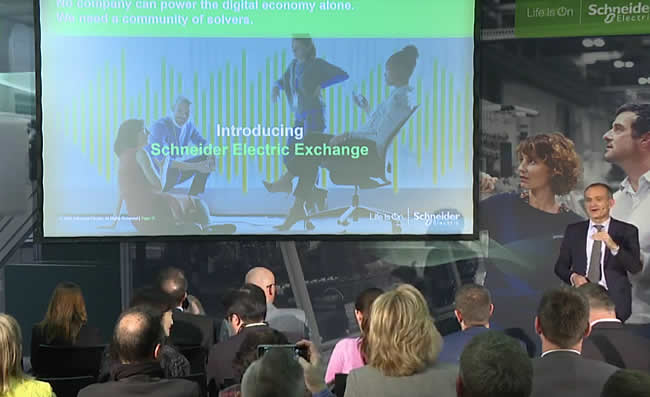Partner ecosystems are essential to succeed in digital transformation for ample organizations in this ‘data age.’ Powered by digital platforms, such ecosystems come in several shapes and forms.
Schneider Electric Exchange, launched less than two years ago (at Hannover Messe – the edition 2019), is an example of an ecosystem that adds value to all stakeholders and is a pillar of the initiators’ overall business strategy.
The aim of the digital ecosystem that had been running in private beta mode for a year before being officially unveiled: ‘driving worldwide economies of scale for IoT solutions.’

And with IoT solutions and Schneider Electric, we’re, of course, in markets where digitalization and digitization are omnipresent with big data, analytics, and AI also playing a pivotal role as part of the essence of Industrial IoT in a broader sense.
Schneider Electric Exchange in a partnership and business acceleration context
But what does driving those worldwide economies of scale for IoT solutions mean in practice? What is Schneider Electric Exchange? How are people and companies using it? And what have been some of the tangible results of the digital ecosystem?
As we’ve entered 2021 and digital remains critical in/for some ‘new normal,’ one thing is clear: Schneider Electric Exchange is a cornerstone in the strategic approach of Schneider Electric, “the leader of digital transformation in energy management and automation.”
In an interview, Nicolas Windpassinger, Global VP of Schneider Electric’s Partner Program, EcoXpert, explained why. Before taking a deeper dive into Exchange in practice, here’s how Nicolas, saw the role of Exchange in combination with the EcoXpert channel program.
Schneider Electric Exchange is part of a three-legged approach, he said, which consists of:
- EcoStruxure, the IoT architecture of the company, and key in the value proposition of the company’s channel partners,
- EcoXpert, the go-to-market and partner program for Schneider Electric and EcoStruxure (with these channel partners being essential in the broader partner ecosystem that Exchange is),
- Exchange as the platform connecting it all with partners (EcoXperts and others) and tools making it serve as a business accelerator for these partners and thus, by definition, for Schneider Electric (and EcoStruxure).
Yet, that’s not all. Rather than just summing up all the possibilities Exchange offers (features and more) or looking at how Exchange is used as we enter 2021, it’s good to take a step back and look at how it fits in an even broader context.
Because it’s precisely this context – and the way Exchange is supported by Schneider Electric and is used by thousands of organizations – that made it the digital ecosystem success it has become.
Schneider Electric Exchange brings together a diverse ecosystem of digital innovators and experts, enabling the co-creation of solutions and enriching learning and speed through collective intelligence. Together this digital ecosystem creates, collaborates, and scales business growth (Cyril Perducat, EVP IoT & Digital Offers, Schneider Electric)
Schneider Electric Exchange – different stakeholders connecting on all digital business levels
Schneider Electric is active in energy management, industrial automation, building management, and related areas across several verticals.
As said, digitization, IoT, so-called Industry 4.0 technologies, and the ability and applications to leverage big data from connected assets and processes are at the core of its business. Remember that term: connecting.
All these mentioned areas evolve with end-customer demands for holistic solutions, revolving around actionable data, as one of the drivers. In practice, this means that silos have to be removed with increasingly digital (yes, again connected) solutions, and the convergence of IT and OT being instrumental. Yet, that alone isn’t enough. Digital transformation, just like Industrial IoT in the broadest sense, in the end, is an ecosystem play because what matters are the people and companies who need to be connected as they all have different roles in value chains, for starters.
Companies like Schneider Electric work with many partners/stakeholders who all – more or less – are on a digital journey and whereby the precise stakeholders obviously depend on the vertical/project. In the case of some partners and areas (take system integrators and critical power facilities, for instance), it’s clear that digital is very much at the core already, even if a lot can still be done.

Other types of partners – take electricians or small panel builders – generally tend to be less far in their digitization journey. Yet, those who see how their markets are changing usually move up a level and go for a more digital offering (also future-proofing themselves and going for recurrent service revenues).
Note: ‘size’ certainly isn’t what keeps some companies from moving (faster). Some electricians understand what home automation expertise can do for them in serving their customers and business better, for example. And small panel builders can be highly forward-thinking and innovative, moving up to a higher level of expertise and even an EcoXpert certification (or several, for that matter).
It’s clear that the evolution towards a more digital, automated, efficient, sustainable, and data-driven world isn’t about to end and that a more connected built environment is inevitable. Moreover, none of the several mentioned – and other types – of companies work alone. Projects require multiple stakeholders (specifiers, contractors, panel builders, integrators, it all depends), and demands from customers, in the end, call for more digital capabilities across the value chain, regardless of the precise area of expertise. Will all partners make this move? No. But those that do and will inevitably get more connected on all levels.
So, let’s focus on that ‘connecting’ again. One could say that connecting is what Schneider Electric in the first place is all about with software, also offered by Schneider Electric’s daughter company AVEVA, and data-driven tools on top of EcoStruxure enabling companies to make the most out of ‘connected data.’
Yet, the connecting happens on several levels at the same time:
- Connecting the right technology partners in a strategic way on a company level (e.g., with mergers and acquisitions, with strategic partnerships, and also with the addition of selected vendors to Exchange).
- Connecting the assets and platforms, all the way from simple digital solutions for specific types of partners to the most advanced EcoStruxure applications, with connected data and the value derived from it as the primary goal.
- Connecting partners, certified EcoXperts, and others that might be on a digital transformation journey but to a lesser degree (for now), start-ups, you name it.
- Connecting people through the Exchange digital ecosystem where the communities and marketplace – that also includes partner solutions – are two driving forces.
How does that enable companies, large and small, to grow their business in practice? In the next article, we’ll look at precisely that with the story of Comfort Laboratory.
Disclosure: i-SCOOP has a commercial collaboration with Schneider Electric. All images are property and courtesy of their respective mentioned owners.

